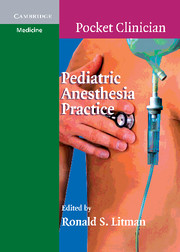Preface
Published online by Cambridge University Press: 10 November 2010
Summary
The care of children in the perianesthetic period requires a unique knowledge base and skill set that differs widely from that required for the anesthetic care of the adult patient. The physiology of organ systems is developing throughout childhood, and thus, anesthetic pharmacology differs correspondingly. Infancy and childhood are associated with a myriad of medical problems that often carry into adolescence and adulthood. For these reasons, anesthesiology residents and anesthesia practitioners who are not experts in pediatric anesthesia require a complete and accurate guide to providing care that is consistent with the standards implemented at the leading children's hospitals. Pediatric Anesthesia Practice aims to provide such a point-of-care guide, utilizing contributions by 61 authors from institutions throughout the world, and edited in a uniform style.
This text is organized into three main sections: Surgical Procedures, Coexisting Diseases, and Regional Anesthesia. The Surgical Procedures section contains details on the anesthetic management of more than 100 common pediatric surgical procedures. Each is divided into six separate important sections that cover the entire perioperative period. These include the common coexisting diseases associated with that particular procedure, preoperative assessment strategies, procedural considerations, anesthetic plan recommendations, pain management strategies, and postoperative considerations.
The section on Coexisting Diseases contains chapters encompassing the most common and most important pediatric diseases with anesthetic implications. Each chapter is divided into four main sections that include information on the aspects of that particular disease, preoperative assessment of patients with that disease, intraoperative management of those patients, and postoperative considerations.
- Type
- Chapter
- Information
- Pediatric Anesthesia Practice , pp. xi - xiiPublisher: Cambridge University PressPrint publication year: 2007
- 1
- Cited by



